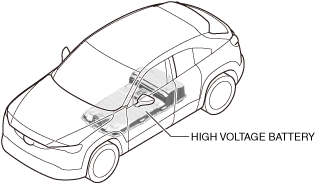HIGH VOLTAGE BATTERY
id304100100100
Purpose
• The high voltage battery supplies power to drive the electric motor. Additionally, it stores the power generated by the electric motor using regenerative braking and the power charged externally.
Functions
• The high voltage battery utilizes lithium-ion chemical reactions to perform charging and discharging.
• The charged power is supplied to each high voltage part to drive and operate the part.
Specification
|
Item
|
Specification
|
|
Battery cell capacity
|
50 Ah
|
|
Number of cells
|
192
|
|
Battery cell voltage
|
3.7 V (2.8 V—4.2 V)
|
|
Number of modules
|
16
|
|
Battery total voltage
|
355 V
|
|
Total energy amount
|
35.5 kW
|
|
Maximum output
|
120 kW (10min)
|
|
Cooling type
|
Refrigerant type
|
|
Warming type
|
Electric heating wires
|
Construction
• The high voltage battery is installed to the underfloor of the vehicle.
• The high voltage battery has a structure using an upper case and lower case which do not allow contact from the outside. In the event of an impact such as a collision, the case is protected to prevent the high voltage circuit from being exposed to the outside.
• The plus side circuit and the minus side circuit of the high voltage battery are separated to prevent a short circuit in the high voltage circuit and to improve safety.
• There are a total of 12 cells inside 1 high voltage battery module. Outputs approx. 22 V per module.
• There are a total of 16 modules in the high voltage battery. Each module is connected in a series and outputs a total of approx. 355 V for 16 modules.
• The high voltage battery has a 2-story structure to secure space for installation to the underfloor.
• The connections between battery modules are connected by bus bars and high voltage cables. By connecting with bus bars, the electrical resistance of the connecting parts is reduced and the connection space is minimized.
• The connections between the 1st-floor module and the 2nd-floor module use high voltage cables because the bus bars cannot absorb the displacement due to vibration.
• Using the high voltage battery at the appropriate temperature allows efficient charging and discharging and prevents the battery performance from deteriorating due to heat. For this reason, a cooling system and heater system have been adopted to the high voltage battery.
Operation
• The high voltage battery cells have positive and negative plates and each plate has the following compositions.
-
― Positive plate: Lithium metal oxide
― Negative plate: Carbon
Charging mechanism
• When an external power supply by charging is connected, the lithium ions on the positive plate escape into the electrolyte as the current moves.
• Charging is performed when the lithium ions in the electrolyte move to the negative plate.
Discharging mechanism
• When a load is connected to the high voltage battery circuit, lithium ions transferred to the negative plate escape into the electrolyte.
• Discharging is performed when the lithium ions in the electrolyte move to the positive plate.
Operation during charging/discharging
